The Role and Influence of Industry 4.0. in Airport Operations in the Context of COVID-19
Abstract
1. Introduction
- Period three to six months after starting pandemic—How a company/business deals with the immediate impacts on and protection of the staff, travel and events, the company/business supply chains, operating locations, demand for the company/business products and services, cash flow, pricing, marketing, and brand reputation.
- The next twelve months—How the company revisits every aspect of the business and operating model—encompassing all of the above—if the virus and resulting economic impacts might continue to affect the company over the upcoming year.
- The next one to three years—How the company can change the shape of the business, location footprint, sourcing, and routes to market, product and service offerings, staffing models, and use of technology if the knock-on effects have a more dramatic impact on the company/business markets and the economy more widely [16].
- Airport operations—The efficiency of overall airport operations aims to optimize resources and improve processes related to maintenance, handling operations, security services, thus eliminating delays or other operational risks.
- Passenger journey—Targets to improve passenger perception and experience by handling congestion, ensuring a continuous flow, thus minimizing queues and maximizing a passenger’s time spent in retail areas.
- Ancillary revenues—Non-aviation revenues can be increased by amending the retail area attractiveness, providing commercial information through mobile apps or digital walls, and using digital capabilities to perform online orders [17].
2. Materials and Methods
3. Background
- Industrial processes can be more easily controlled when there is real-time data at all production processes,
- Computer control, optimization, and automation can improve productivity and produce better quality and personalized products [29].
4. Results
4.1. Smart Airport Assumptions in the Context of COVID-19
- Smart Airport Mobility means sustainable mobility of passengers, employees, and other airport visitors. This refers to the fastest route and the use of different means of transport such as subways, railways, bicycles, and electric cars. The capacity of access roads and parking lots should be sufficient.
- Smart Airport Logistics implies the appropriate dynamics of procurement of goods and services required for airport operations, traffic routes that connect the airport with cities in the vicinity and the wider geographical area. All the logistics elements that makeup Smart Airport Logistics should also be based on smart technologies.
- Smart Airport Infrastructure includes a passenger terminal, runway, apron, and other operating areas managed sustainably, using ICT. Apart from the passenger infrastructure, the same applies to the cargo infrastructure (warehouse, access roads, parking lot, exit to the parking lot, etc.).
- Smart Airport Services include automated business processes of aircraft, passengers, cargo, and mail handling in all phases while minimizing the activities performed by the airport’s operational staff.
- Smart Airport Equipment reduces physical human work, speeds up airport operations, and minimizes the environment’s negative impact.
- Smart Airport Grids are necessary for Smart Airport Services, Smart Airport Infrastructure, Smart Airport Logistics, Smart Airport Mobility, and the functioning of Smart Airport Equipment.
- technologies are constantly evolving.
- the requirements of airport service users are constantly changing.
- airport infrastructure requires a constant investment that takes place in cycles
4.2. Smart Airport Human Resource Management
5. Discussion
- Check-in: allowing passengers to receive their boarding pass via self-service channels (web, kiosk, mobile phone, or automated), avoiding long lines at check-in desks.
- Biometrics: as airports and airlines invest in digitization of all passenger touchpoints and implement self-service systems (check-in, bag drop, security, boarding), biometrics will become the preferred technology for identity management. Furthermore, biometric data, when linked with boarding pass data, is of immense value to airport operators. These datasets will allow a transformation of airport business models, as airports learn more about passengers and can develop personalized products and services.
- Bags ready-to-go: enabling passengers to deliver their bags tagged and ready for acceptance. This self-tagging could be done at kiosks, through Home Printed Bag Tags or Electronic Bag Tags. Baggage would then be accepted by an airline representative or a self-service bag drop.
- Document scanning: allowing passengers to scan their travel documents at kiosks for data verification and compliance with destination and transit requirements.
- Flight rebooking: allowing passengers to get proactively rebooked and obtain their new boarding pass via a self-service channel such as kiosks in case of delays or cancellations, thus avoiding long lines.
- Self-boarding: allowing passengers to self-scan their boarding token to gain entry to the aircraft, potentially using automated boarding gates similar to a train or metro station.
- Bag recovery: enabling passengers to report a missing bag via a self-service channel instead of waiting in line at a baggage claim service counter.
- Robots: there was lots of talk about customer-facing robots that can provide on-the-spot assistance to passengers but it is perhaps in operational roles that robotics will have the most telling impact. Many airports are already utilizing robots somehow, such as Tokyo International Airport. Many others are planning to follow through.
- Collaborative decision-making: airport collaborative decision-making aims at improving the overall efficiency of airport operations by optimizing the use of resources and improving the predictability of events. It focuses especially on aircraft turn-round and pre-departure sequencing processes. Increased predictability can be of significant benefit for all major airport and network operations; it raises both productivity and cost-efficiency. These benefits will apply to the Airport Operator, Airline, Air Traffic Control, Ground Handler, Passengers, and the entire aviation network.
- One ID by IATA: one ID seeks to introduce a collaborative identity management solution that spans all process steps and stakeholders in the end-to-end journey from booking to arrival at destination and back, putting the passenger in the centre. The concept relies on early validation of the passengers’ identity, and controlled access to this information by the various public and private stakeholders on an authorized-to-know basis, so that the passenger can be recognized and attended to in the most efficient way in subsequent process steps. One ID introduces an opportunity for the passenger to further streamline their journey with a document-free process based on identity management and biometric recognition. Passengers will be able to identify themselves at each airport touchpoint through a simple biometric recognition. The objective is to achieve a truly interoperable system coordination between airports, airlines, and governments.
6. Conclusions
Author Contributions
Funding
Acknowledgments
Conflicts of Interest
References
- World Health Organisation. Novel Coronavirus (2019-nCoV)—Situation Report-1; WHO: Geneva, Switzerland, 2020. [Google Scholar]
- World Health Organization Website. Updated WHO Recommendations for International Traffic in Relation to COVID-19 Outbreak, COVID-19 Travel Advice. 29 February 2020. Available online: https://www.who.int/news-room/articles-detail/updated-who-recommendations-for-international-traffic-in-relation-to-covid-19-outbreak (accessed on 5 August 2020).
- World Health Organization Website. Timeline of WHO’s Response to COVID-19, Statement. 29 June 2020. Available online: https://www.who.int/news/item/29-06-2020-covidtimeline (accessed on 16 August 2020).
- Kaminski-Morrow, D. All-Cargo Flights Stay Level as Passenger Traffic Collapses; Eurocontrol: Brussels, Belgium, 30 March 2020; Available online: https://www.flightglobal.com/air-transport/eurocontrol-all-cargo-flights-stay-level-as-passenger-traffic-collapses/137623.article (accessed on 30 March 2020).
- Forsyth, P.; Guiomard, C.; Niemeier, H.M. The collapse in passenger demand and airport charges. J. Air Transp. Manag. 2020, 89, 101932. [Google Scholar] [CrossRef] [PubMed]
- International Civil Aviation Organization (ICAO). State of Global Air Transport and ICAO Forecasts for Effective Plannin; Economic Development, Air Transport Bureau, ICAO: Montreal, QC, Canada, 2020. [Google Scholar]
- International Air Transport Association (IATA). Air Passenger Demand Comes to a Standstill Amidst Lockdowns; Air Passenger Market Analysis; IATA: Montreal, QC, Canada, 2020. [Google Scholar]
- Kotoky, A.; Stringer, D.; Saxena, R. Two-Thirds of the World’s Passengers Jets Are Grounded Amid COVID-19 Pandemic. Available online: https://time.com/5823395/grounded-planes-coronavirus-storage/ (accessed on 19 June 2020).
- International Civil Aviation Organization (ICAO). Effects of Novel Coronavirus (COVID-19) on Civil Aviation: Economic Impact Analysis; Air Transport Bureau: Montréal, QC, Canada, 3 December 2020. [Google Scholar]
- Kotoky, A.; Modi, M.; Turner, M. Jobs Are Being Wiped Out at Airlines, and There’s Worse to Come; Bloomberg: New York, NY, USA, 2020; Available online: https://www.bloombergquint.com/business/400-000-jobs-lost-at-airlines-during-coronavirus-pandemic (accessed on 21 August 2020).
- Airports Council International (ACI). Latest Traffic Data Shows Disastrous COVID-19 Impact on Airport Industry. 7 August 2020. Available online: https://www.aci-europe.org/press-release/270-latest-traffic-data-shows-disastrous-covid-19-impact-on-airport-industry.html (accessed on 4 October 2020).
- Airports Council International (ACI). Predicted Global Impact of COVID-19 on Airport Industry escAlates. 5 May 2020. Available online: https://aci.aero/news/2020/05/05/predicted-global-impact-of-covid-19-on-airport-industry-escalates/ (accessed on 2 December 2020).
- Eurocontrol. Draft Traffic Scenarios for September 2020—February 2021: Impact of State Restrictions, Uncoordinated Approach and Uncertainty over COVID-19; Eurocontrol: Brussels, Belgium, 2020. [Google Scholar]
- OAG. Coronavirus—How and When Will Aviation Recover from Covid-19? September 2020. Available online: https://www.oag.com/coronavirus-airline-schedules-data (accessed on 7 October 2020).
- Nakamura, H.; Managi, S. Airport risk of importation and exportation of the COVID-19 pandemic. Transp. Policy 2020, 96, 40–47. [Google Scholar] [CrossRef] [PubMed]
- Serrano, F.; Kazda, A. The future of airports post COVID-19. J. Air Transp. Manag. 2020, 89, 101900. [Google Scholar] [CrossRef] [PubMed]
- Zahariaa, S.E.; Pietreanub, C.V. Challenges in airport digital transformation. Transp. Res. Procedia 2018, 35, 90–99. [Google Scholar] [CrossRef]
- Nikolić, G.; Rogale, D. Industrija 4.0—Pravac Razvoja Tekstilne i Odjevne Industrije. Tekstil 2017, 66, 65–73. [Google Scholar]
- Liao, Y.; Deschamps, F.; Freitas, E.D.; Loures, R. Past, present and future of Industry 4.0—A systematic literature review and research agenda proposal. Int. J. Prod. Res. 2017, 55, 3609–3629. [Google Scholar] [CrossRef]
- Nikolić, G. Is industry 5.0 responding to industry 4.0 or its resume? Polytech. Des. 2018, 6, 1–8. [Google Scholar]
- Barretoa, L.; Amarala, A.; Pereiraa, T. Industry 4.0. implications in logistics: An overview. In Proceedings of the Manufacturing Engineering Society International Conference 2017, Pontevedra, Spain, 28–30 June 2017. [Google Scholar]
- Mrugalska, B.; Wyrwicka, M.K. Towards Lean Production in Industry 4.0. Procedia Eng. 2017, 182, 466–473. [Google Scholar] [CrossRef]
- Qin, J.; Liu, Y.; Grosvenor, R. A Categorical Framework of Manufacturing for Industry 4.0 and Beyond. Procedia CIRP 2016, 52, 173–178. [Google Scholar] [CrossRef]
- Schwab, K. The Fourth Industrial Revolution, What It Means and How to Respond. 2016. Available online: https://www.weforum.org/agenda/2016/01/the-fourth-industrial-revolution-what-it-means-and-how-to-respond/ (accessed on 2 September 2020).
- Tay, S.I.; Lee, T.C.; Hamid, N.A.A.; Ahmad, A.N.A. An Overview of Industry 4.0: Definition, Components, and Government Initiatives. J. Adv. Res. Dyn. Control Syst. 2018, 10, 1379–1387. [Google Scholar]
- Marcos, M.; Suárez, S.; Marcos, M.; Fernández-Miranda, S.S.; Marcos, M.; Peralta, M.E.; Aguayo, F. The challenge of integrating Industry in the degree of Mechanical Engineering. Procedia Manuf. 2017, 13, 1229–1236. [Google Scholar]
- Wang, S.; Wan, J.; Li, D.; Zhang, C. Implementing Smart Factory of Industrie 4.0: An Outlook. Int. J. Distrib. Sens. Netw. 2016, 6, 1–10. [Google Scholar] [CrossRef]
- Smit, J.; Kreutzer, S.; Moeller, C.; Carlberg, M. Industry 4.0; European Union: Brussels, Belgium, 2016; p. 7. [Google Scholar]
- Crnjac, M.; Veža, I.; Banduka, N. From Concept to the Introduction of Industry 4.0. Int. J. Ind. Eng. Manag. 2017, 8, 21–30. [Google Scholar]
- Vujić, V. Menadžment Ljudskog Kapitala; Fakultet za Turistički i Hotelski Menadžment Opatija, Sveučilište u Rijeci: Rijeka, Croatia, 2004. [Google Scholar]
- Elwood, F.H., II; James, W.T., Jr. Trends toward a Closer Integration of Vocational Education and Human Resources Development. J. Vocat. Tech. Educ. 1996, 12, 49–57. [Google Scholar]
- Cook, M.; Cripps, B. Psihološko Procjenjivanje na Radnome Mjestu; Školska knjiga: Zagreb, Croatia, 2009. [Google Scholar]
- Huić, A.; Ricijaš, N.; Branica, V. Kako definirati i mjeriti kompetencije studenata—Validacija skale percipirane kompetentnosti za psihosocijalni rad. Ljetop. Soc. Rada 2010, 17, 195–221. [Google Scholar]
- Kaslow, N.J.; Borden, K.A.; Collins, F.L., Jr.; Forrest, L.; Illfelder-Kaye, J.; Nelson, P.D.; Rallo, J.S. Competencies conference: Future directions in education and credentialing in professional psychology. J. Clin. Psychol. 2004, 60, 699–712. [Google Scholar] [CrossRef] [PubMed]
- Ould, A.M. Business Processes; John Wiley & Sons Ltd.: Chichester, UK, 1995. [Google Scholar]
- Drljača, M. Career management in the function of the management system quality. Sci. J. Saf. Eng. 2012, 2, 149–154. [Google Scholar]
- Drljača, M.; Petar, S.; Raad, M. Development potential of passenger and baggage handling process on airports. In Proceedings of the 20th International Symposium on Quality. Quality—Yesterday, Today, Tomorrow, Pula, Croatia, 20–22 March 2019; Croatian Quality Managers Society: Zagreb, Croatia, 2020; Volume 20, pp. 257–271. [Google Scholar]
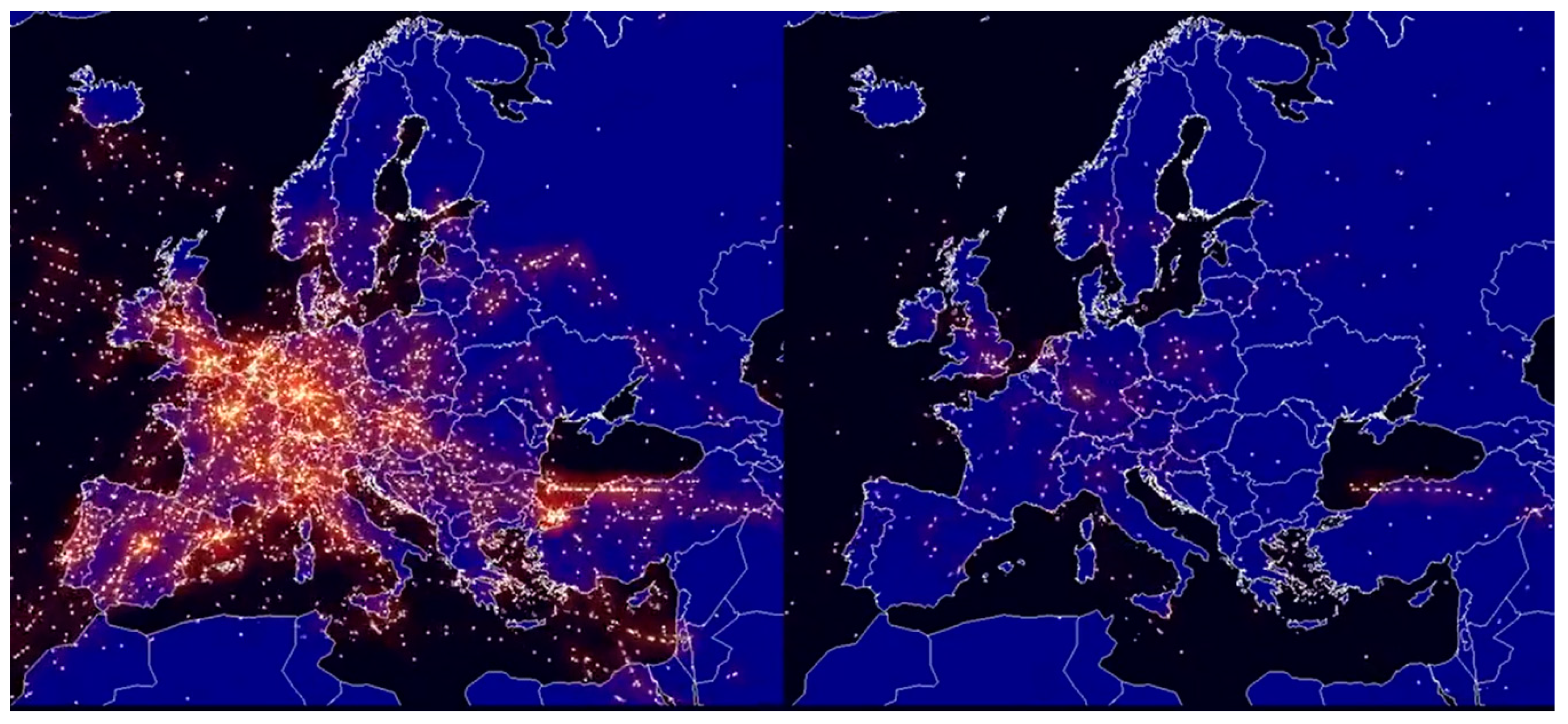
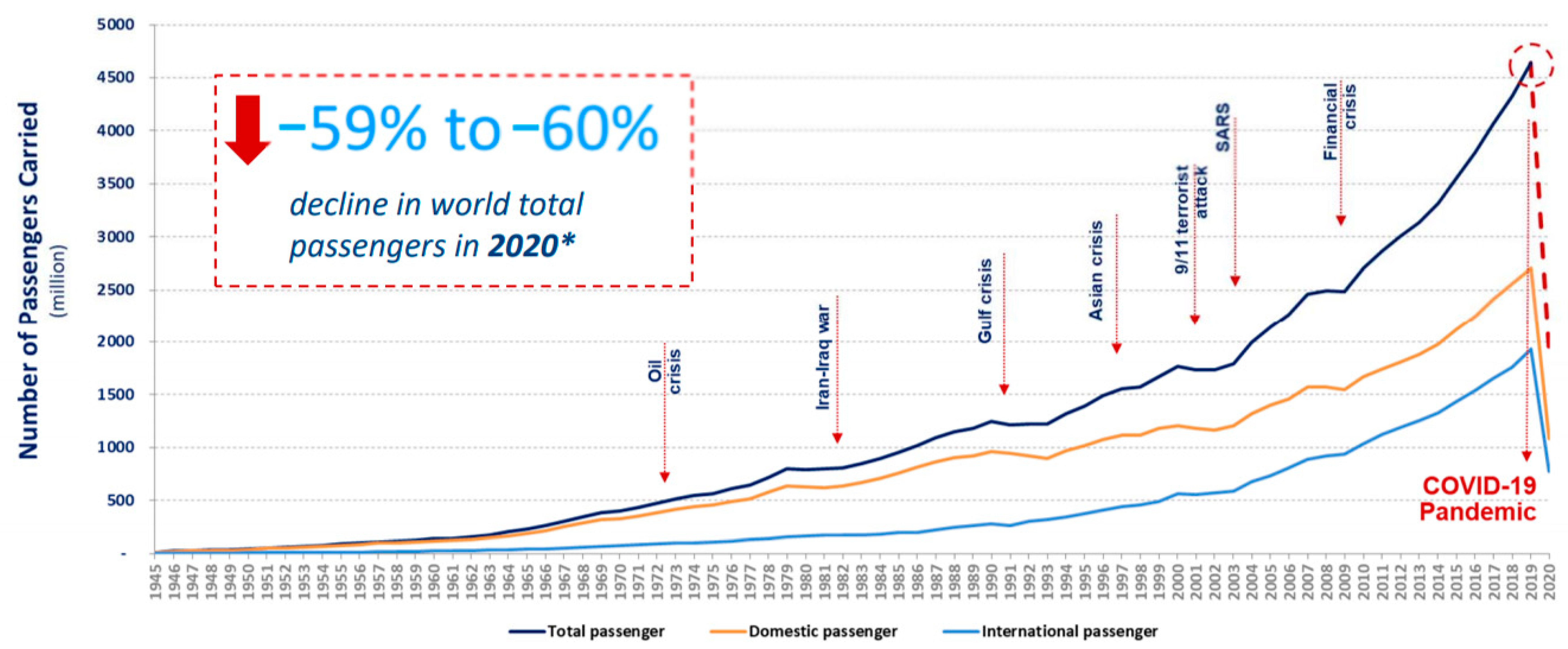
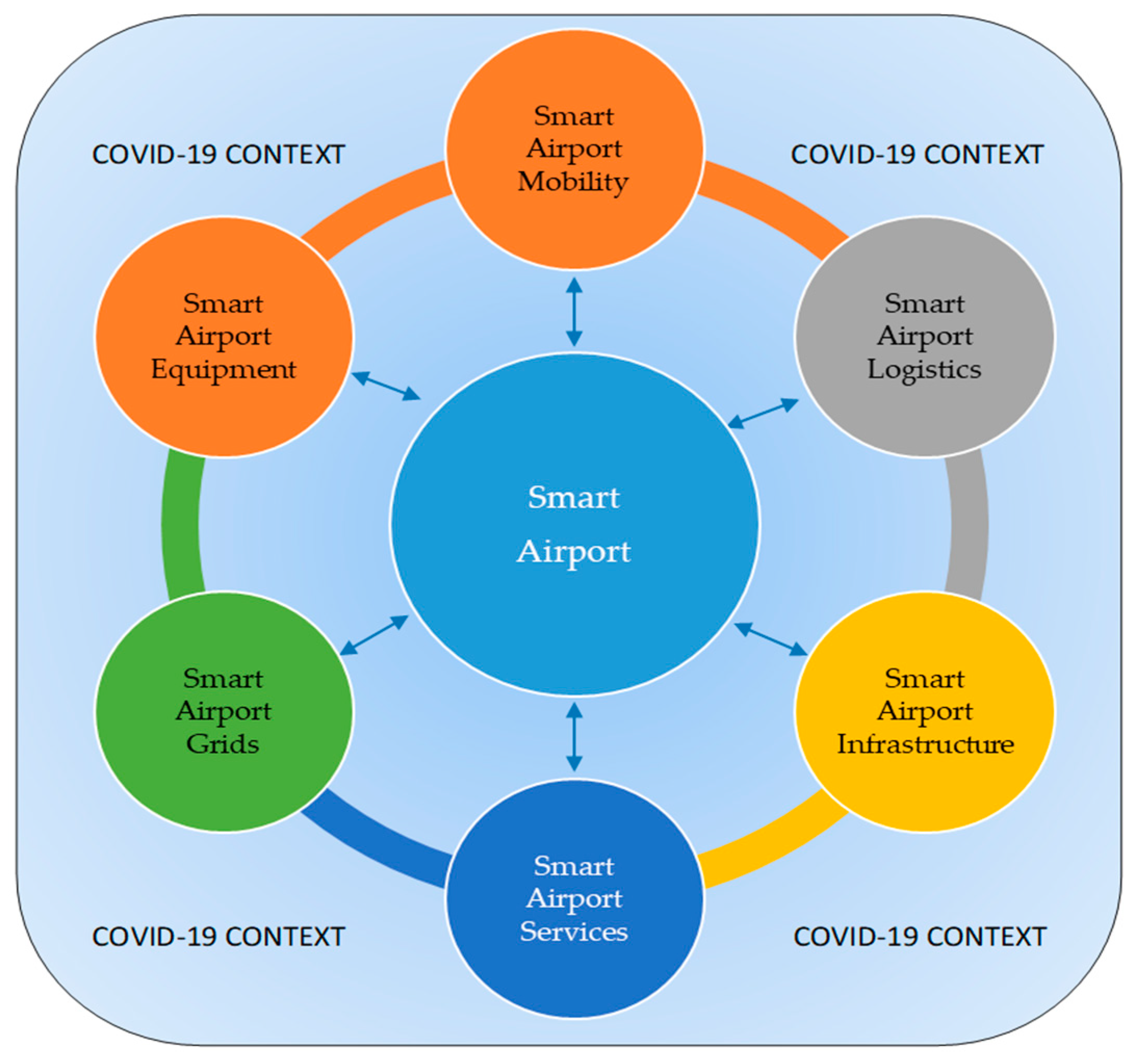
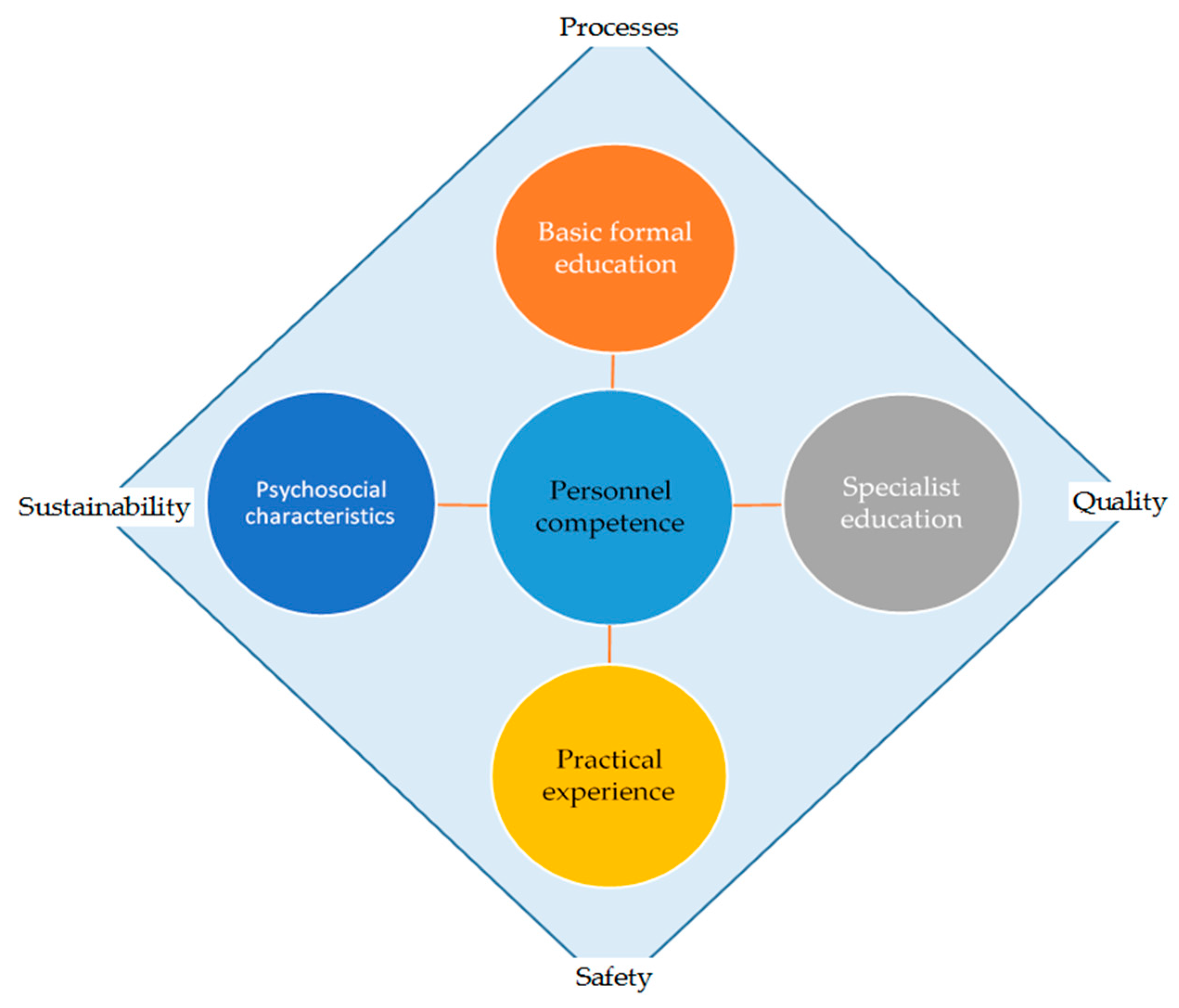
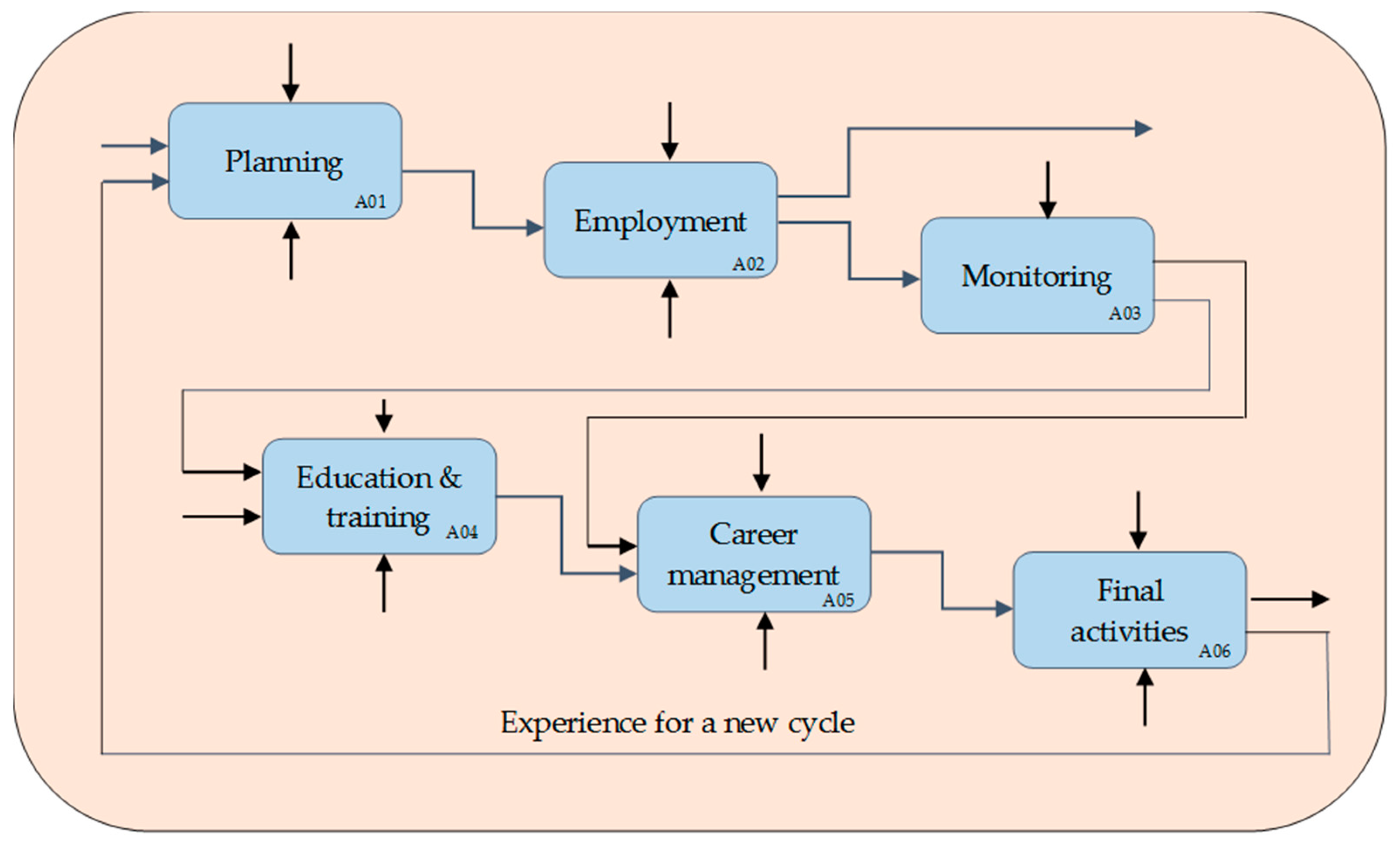
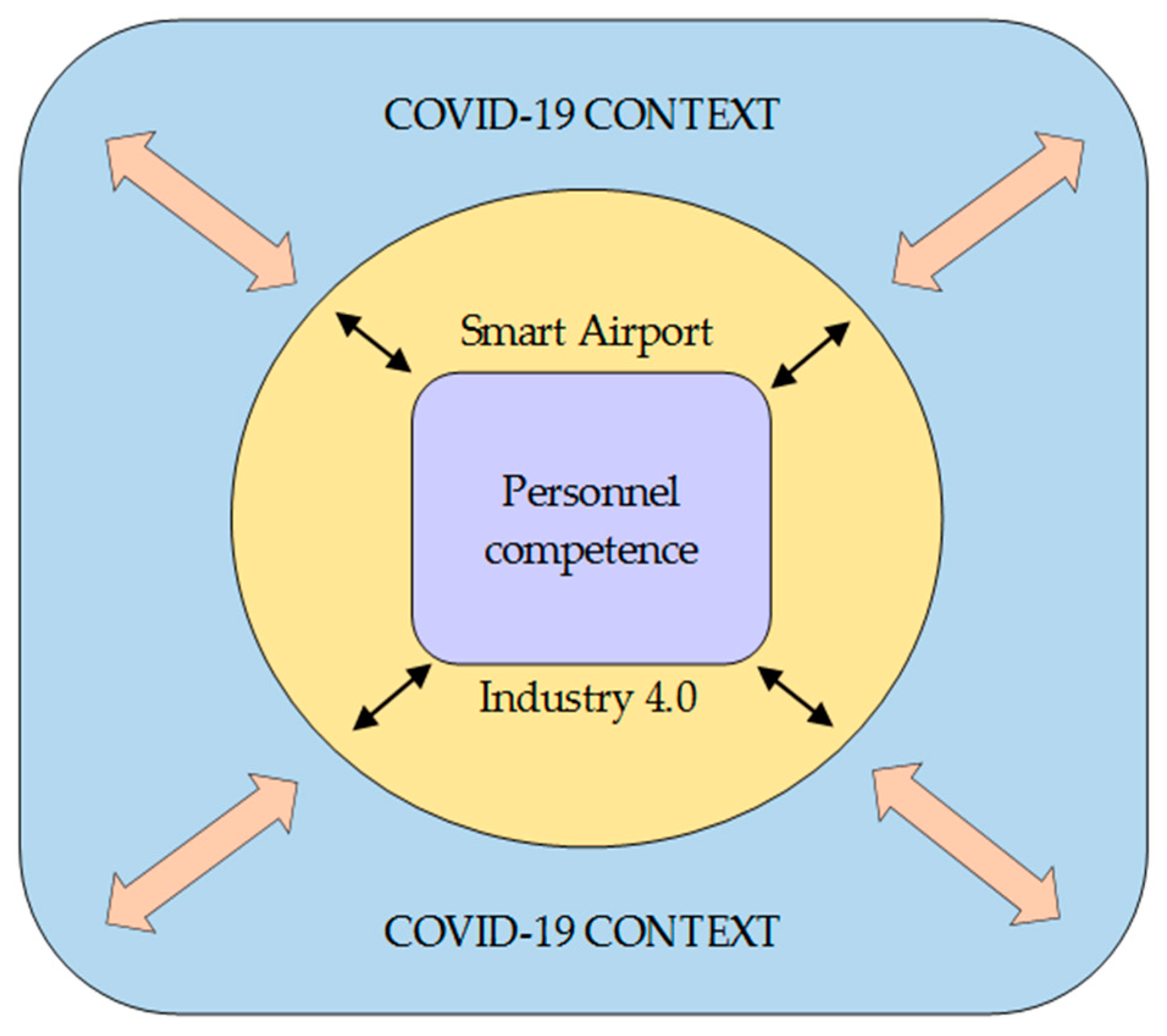
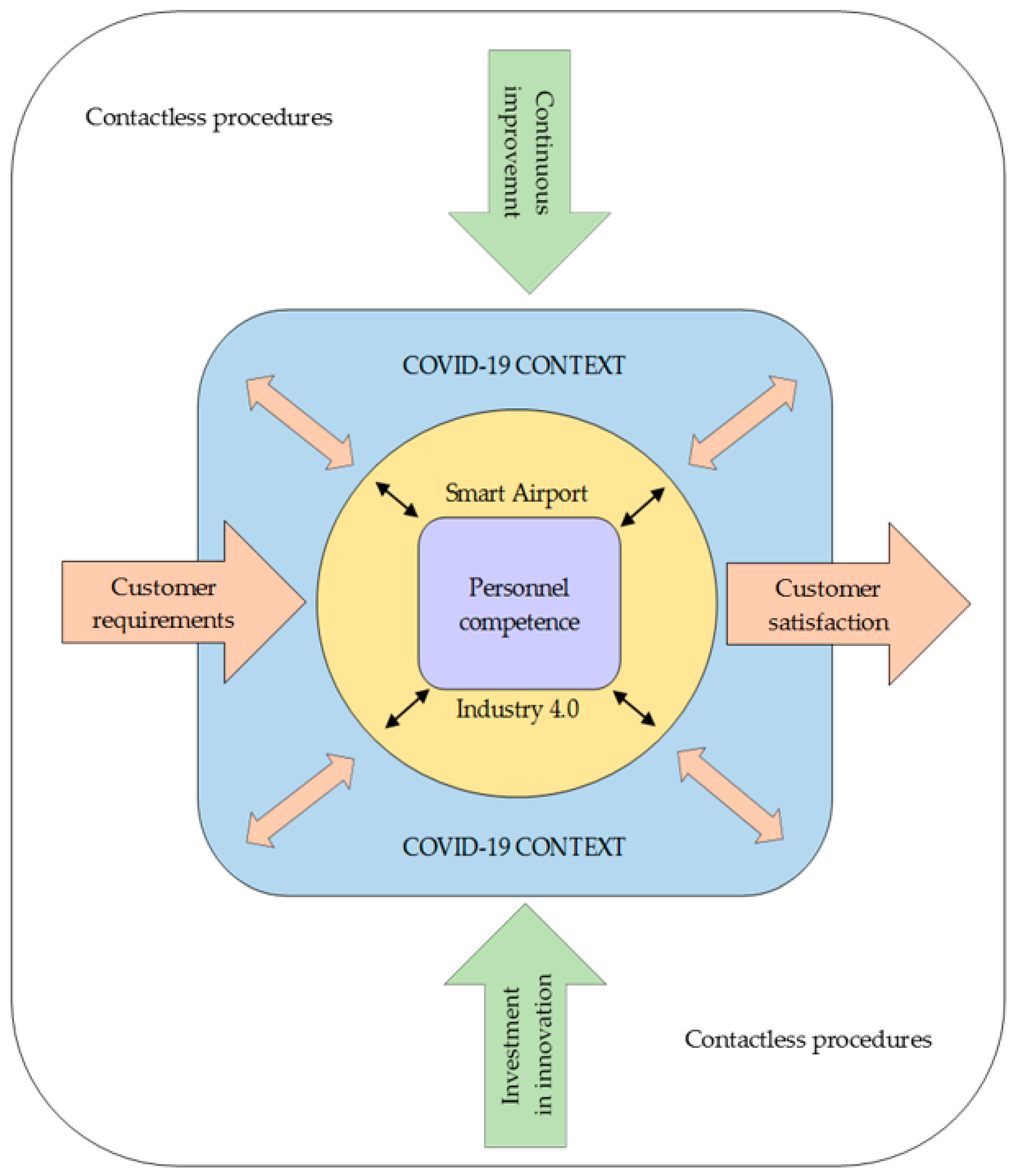
| Terminal Subsystem | Pre-COVID-19 Passenger Flow | COVID-19 Passenger Flow and Future Vision with Industry 4.0 | ||
|---|---|---|---|---|
| Technology | Social Contact | Technology | Social Contact | |
| Check in (CKI) | Most of the passengers use conventional check-in desk service (direct contact between passenger and airport staff) | Yes | Using conventional Check-In service will be decreased as focus will be on contactless technology. Using of CKI desk service will be additionally paid. | Yes/ No |
| Self-Service Kiosk—the average number of passengers (mostly business passengers) use Common use self-service (CUSS) due to a lack of IT knowledge | No | Self- Service kiosks will become the standard technology for passenger check-in. The additional value will be that during CKI, passenger data from the passport will be correlated with the biometrics (face recognition) used as an identity base through the entire traffic flow process. | No | |
| Bag Drop Desk—if there is no automated bag drop, passengers after CUSS of web check-in are going to the Drop-Off counter (direct contact between passenger and airport staff) | Yes | Bag Drop Desk will be fully automated without any contact with the airport staff. | No | |
| Internet CKI—low rate of using Internet/Web Check-In | No | Internet CKI will have a high usage rate because most passengers will use their IT equipment for CKI. | No | |
| Boarding Pass Control | Most of the airports still airport stuff for checking boarding pass (direct contact between passenger and airport staff) | Yes | All the airports will use automated boarding pass control equipment where employees will be monitoring the entire process from a distance (separate office). | No |
| Security Control | Most of the airports use conventional security equipment where four persons need to be in place for one security unit (direct contact between passenger and airport staff) | Yes | Airport Security will be using highly sophisticated equipment, including scanning cabin (a touchless, digital alternative to physical security). The officers will monitor the entire process from a distance (separate office) and will react only if the alarm is on. | No |
| Emigration/ Immigration Control | Emigration and Immigration are provided by police, and most of the airport use a conventional approach with emigration counters (direct contact between passenger and police officer) | Yes | The airport will implement technology which will provide biometrics and date from the mobile (passenger face will become boarding pass). | No |
| Boarding | Most of the airport is using a conventional boarding process using gate counters (direct contact between passenger and airport staff) | Yes/ No | Automated gate readers and face recognition will create contactless boarding checks while airport employees will monitor the entire process from a distance office. | No |
Publisher’s Note: MDPI stays neutral with regard to jurisdictional claims in published maps and institutional affiliations. |
© 2020 by the authors. Licensee MDPI, Basel, Switzerland. This article is an open access article distributed under the terms and conditions of the Creative Commons Attribution (CC BY) license (http://creativecommons.org/licenses/by/4.0/).
Share and Cite
Drljača, M.; Štimac, I.; Bračić, M.; Petar, S. The Role and Influence of Industry 4.0. in Airport Operations in the Context of COVID-19. Sustainability 2020, 12, 10614. https://doi.org/10.3390/su122410614
Drljača M, Štimac I, Bračić M, Petar S. The Role and Influence of Industry 4.0. in Airport Operations in the Context of COVID-19. Sustainability. 2020; 12(24):10614. https://doi.org/10.3390/su122410614
Chicago/Turabian StyleDrljača, Miroslav, Igor Štimac, Matija Bračić, and Saša Petar. 2020. "The Role and Influence of Industry 4.0. in Airport Operations in the Context of COVID-19" Sustainability 12, no. 24: 10614. https://doi.org/10.3390/su122410614
APA StyleDrljača, M., Štimac, I., Bračić, M., & Petar, S. (2020). The Role and Influence of Industry 4.0. in Airport Operations in the Context of COVID-19. Sustainability, 12(24), 10614. https://doi.org/10.3390/su122410614






